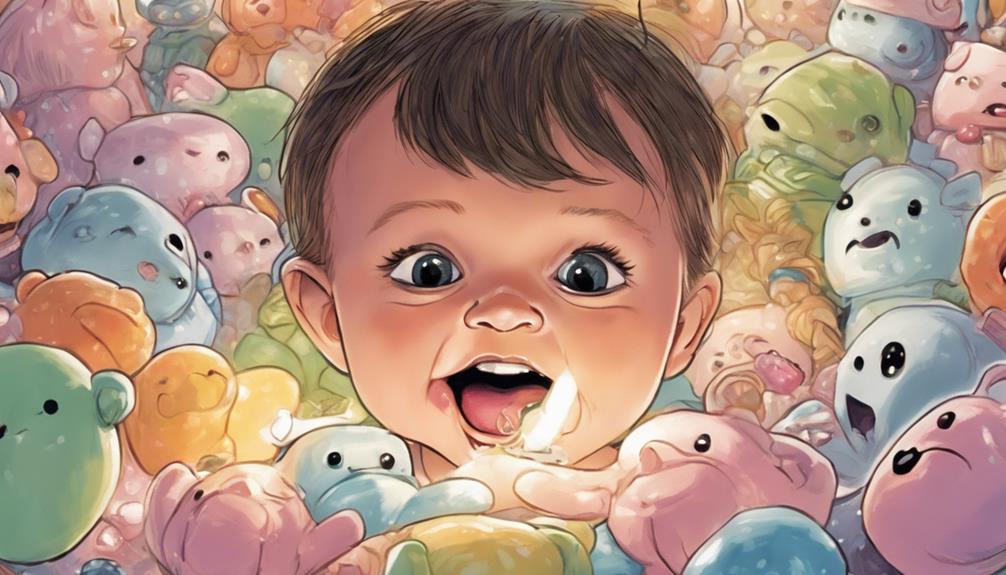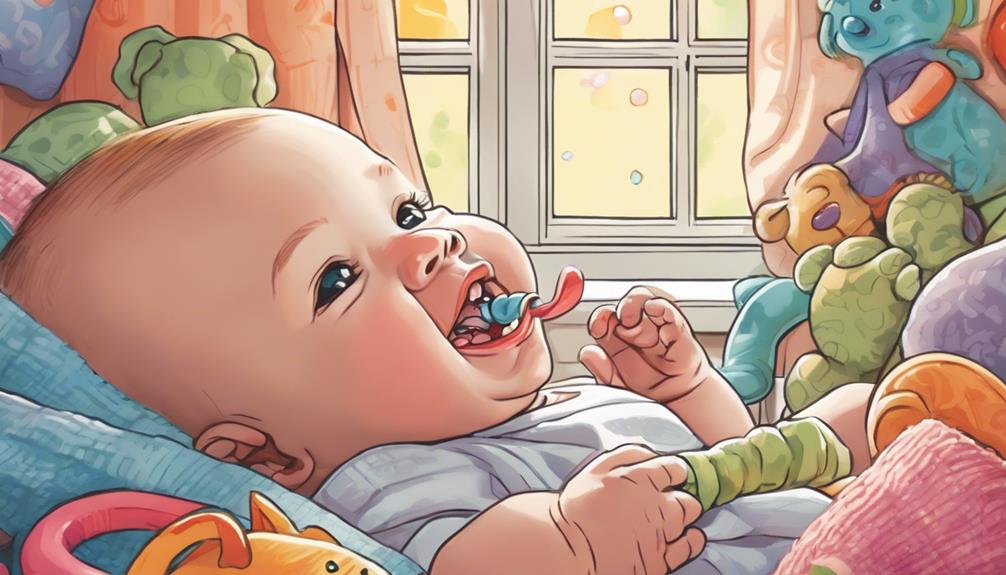Baby teeth, or deciduous teeth, originate from early development in the gums during pregnancy. By the time your baby is born, the foundations for 20 primary teeth are already formed. These teeth start to emerge between 6 months and 3 years of age, typically beginning with the lower central incisors. They play essential roles in chewing and speaking, while also guiding the alignment of permanent teeth. As they grow, you'll notice teething symptoms like drooling and irritability. Curious about what happens next in your child's dental journey? There's a lot more to discover about their oral health and care.
Key Takeaways
- Baby teeth, or deciduous teeth, develop in the gums during pregnancy, beginning formation early in fetal development.
- A total of 20 primary teeth emerge through the gums between 6 months and 3 years of age.
- The eruption of baby teeth starts with the lower central incisors, followed by other tooth types in a specific order.
- Primary teeth serve essential functions, aiding in chewing, speaking, and guiding the alignment of permanent teeth.
Overview of Baby Teeth

Baby teeth, also known as deciduous teeth, begin developing in the gums during pregnancy and play an important role in your child's early development. By the time your baby is born, these primary teeth are typically present, even if they're not visible yet. On average, children have 20 baby teeth that emerge between 6 months and 3 years of age.
The eruption process starts with the lower central incisors, which makes sense as they help your child begin chewing and speaking effectively. Following these initial teeth, the upper central incisors come in, and eventually, the molars and canines appear. These primary teeth serve crucial functions, including guiding the proper alignment of permanent teeth.
Around ages 6 to 7, baby teeth begin to exfoliate, paving the way for permanent teeth, which total 32 in an average adult by age 21. Ensuring good dental health during this time is essential, as primary teeth are important for proper growth and development. By keeping an eye on your child's dental health, you're setting the stage for a healthy smile that lasts a lifetime.
Development Timeline
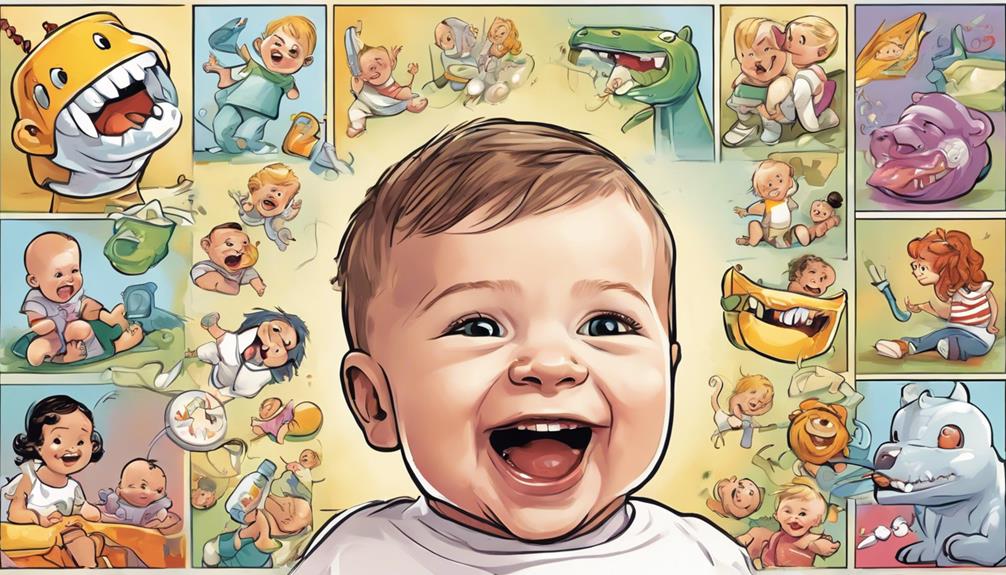
As your child grows, you'll notice specific stages in the eruption of their primary teeth.
Understanding these stages can help you recognize teething symptoms and signs, making the process easier for both of you.
Let's explore what to expect during this important timeline.
Primary Teeth Eruption Stages
Typically, children start to see their first primary teeth erupt between 6 to 12 months of age, beginning with the lower central incisors. This eruption marks an exciting milestone in your child's development. After the central incisors, the upper central incisors follow, usually appearing by around 8 to 12 months.
Next, you can expect the upper lateral incisors to emerge around 9 to 13 months, followed by the lower lateral incisors at about 10 to 16 months. By the time your child reaches 3 years old, they typically have a complete set of 20 primary teeth, which include the canines, first molars, and second molars.
The eruption process tends to occur systematically, with an average of one tooth emerging roughly every month after the first teeth appear. However, keep in mind that timing can vary considerably among children.
If your child hasn't started teething by 12 months, it's a good idea to consult with your dentist to rule out any concerns. Being aware of these stages can help you support your child during this important time.
Teething Symptoms and Signs
Teething symptoms usually emerge around 4 to 7 months of age, often intensifying as the first teeth begin to break through the gums. You might notice signs of discomfort in your baby, which can include increased drooling and irritability. Many parents report that their little ones want to chew on objects to alleviate teething pain.
Here's a quick overview of common teething symptoms:
| Symptoms | Description | Timing |
|---|---|---|
| Increased Drooling | Excess saliva production | Begins around 4-7 months |
| Irritability | Fussiness and crying | Heightens with each tooth |
| Swollen Gums | Tenderness as teeth approach | A few days before eruption |
| Chewing on Objects | Desire to bite and chew | Common during teething |
| Slight Fever | Temperature increase (not true fever) | May occur during teething |
As your baby's gums swell, you may notice they seem more uncomfortable than usual. Typically, symptoms can last a few days before the emergence of each tooth, so keeping an eye on these signs will help you navigate this phase with greater ease.
Teething Symptoms
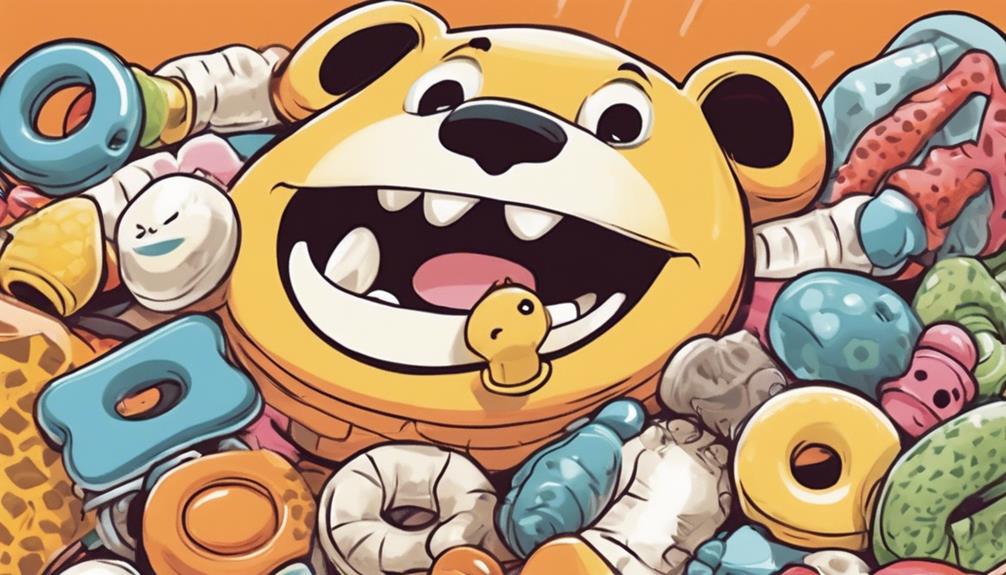
Around 4 to 7 months of age, you'll likely notice your baby showing signs of teething as their teeth start to break through the gums. Common teething symptoms include increased drooling, which can sometimes soak through their clothes. You might also observe irritability as your little one experiences gum discomfort. They'll likely want to chew on various objects to soothe their swollen gums, which can feel tender to the touch.
In the weeks leading up to a tooth's eruption, you may notice your baby's gums becoming visibly swollen. This is completely normal and part of the teething process. While slight temperature elevations can happen, remember that a true fever isn't a typical teething symptom and could signal other issues.
To help ease their discomfort, you might consider using teething gels or providing cold teething rings for them to chew on. Fussiness and disrupted sleep patterns can occur during this time but are usually temporary, lasting about 48 hours during significant teething events.
Keeping a close eye on these symptoms will help you support your baby through this natural milestone.
Eruption Order
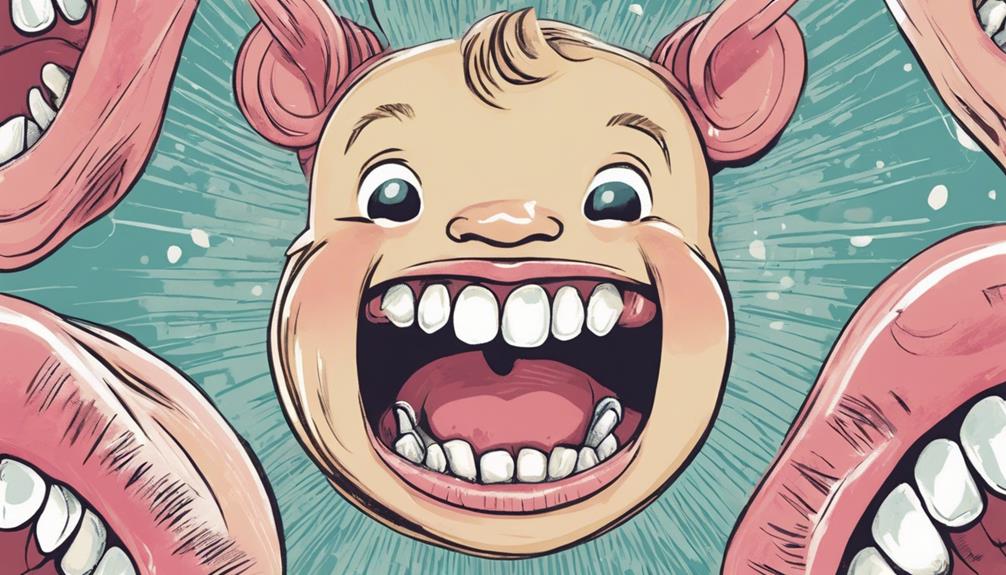
When it comes to baby teeth, understanding the eruption order can help you track your child's dental development.
Typically, the lower central incisors are the first to come in, followed by a specific sequence that most kids follow.
Knowing this timeline can give you peace of mind as you monitor your little one's progress.
Typical Eruption Sequence
The typical eruption sequence for primary teeth kicks off with the lower central incisors, which usually emerge between 6 and 12 months of age.
As your child's teeth begin to erupt, you'll notice a specific order that helps track their dental development. Here's what to expect:
- Lower central incisors: 6-12 months
- Upper central incisors: 8-12 months
- Upper lateral incisors: 9-13 months
- Lower lateral incisors: 10-16 months
After the first molars, the canines, or cuspids, come in between 16 and 23 months. Finally, the second molars typically emerge between 25 and 33 months, rounding out the set of 20 primary teeth by age 3.
This eruption order is essential as it lays the foundation for your child's dental health. Each set of teeth plays a role in chewing, speaking, and maintaining space for permanent teeth.
Primary Teeth Timeline
Understanding your child's primary teeth timeline helps you anticipate when each tooth will make its appearance. Typically, primary teeth, or deciduous teeth, start to erupt between 6 to 12 months. The first to appear are the lower central incisors, usually followed by the upper central incisors about 4 to 8 weeks later.
Here's a quick overview of the eruption order:
| Tooth Type | Age of Eruption | Notes |
|---|---|---|
| Lower Central Incisors | 6 to 10 months | First primary teeth to erupt |
| Upper Central Incisors | 8 to 12 months | Erupts shortly after lower |
| Complete Set of Primary Teeth | By age 3 | 20 teeth in total |
Importance of Oral Hygiene
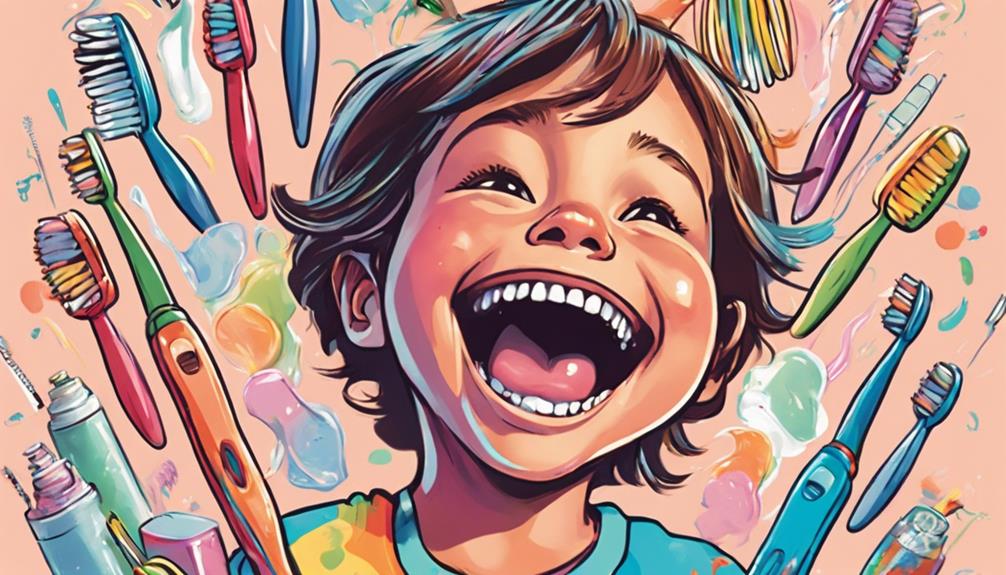
Maintaining good oral hygiene from the very start is essential for your child's dental health and future development. Establishing a routine early on can help prevent tooth decay and guarantee healthy baby teeth pave the way for strong permanent ones. Here are some key practices to incorporate:
- Clean your baby's gums with a soft cloth from birth to prevent bacteria buildup.
- Start brushing with plain water twice daily as soon as the first tooth appears, usually around 6-12 months.
- Introduce fluoride toothpaste at 18 months, using only a smear to avoid dental fluorosis.
- Schedule regular dental check-ups by age 1 or after the first tooth emerges to monitor development.
Neglecting these practices can lead to serious issues, including tooth decay, which may affect the health and alignment of future permanent teeth.
Nutritional Considerations

Proper nutrition during pregnancy and infancy is crucial for developing strong baby teeth and supporting overall oral health. To guarantee ideal tooth development, focus on a balanced diet rich in key nutrients like calcium, vitamin D, and phosphorus.
Calcium is essential for forming strong tooth enamel, so include dairy products and leafy greens in your diet. Vitamin D plays a critical role in calcium absorption, making it equally important for your baby's dental health.
After birth, continue to prioritize your child's nutrition by offering a variety of foods that support their developing teeth. Introducing fluoride, either through drinking water or supplements as recommended by your pediatrician, can help strengthen enamel and prevent decay in those emerging baby teeth.
Additionally, maintain a diet low in sugars and processed foods, as excessive sugar intake can lead to tooth decay in both baby and permanent teeth.
Breastfeeding or providing formula also contributes crucial nutrients for healthy teeth and gums in infants. By considering these nutritional factors, you're setting the foundation for a lifetime of good oral health for your child.
Soothing Teething Discomfort

Teething can be uncomfortable for your baby, but there are effective ways to soothe their discomfort. You can ease their teething pain using a few simple methods that provide relief and comfort.
- Chilled teething rings: Offer your baby a teething ring that you've chilled in the fridge. The cold helps soothe sore gums.
- Frozen washcloths: Dampen a washcloth and place it in the freezer for a short time. Let your baby chew on it to help relieve teething discomfort.
- Clean fingers: Gently massage your baby's gums with a clean finger. This can provide immediate relief from teething pain.
- Distraction: Engage your baby with toys or activities to take their mind off the discomfort. Sometimes, a little fun can make a big difference.
Dental Care Recommendations
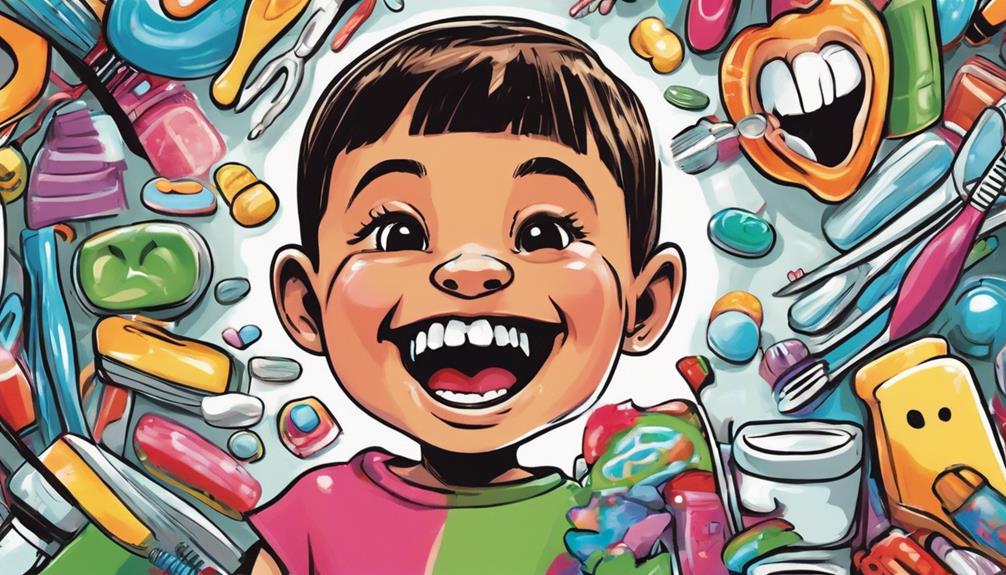
As your baby's teeth begin to emerge, it's important to establish a dental care routine that supports their oral health from the very start. Begin by cleaning your baby's gums with a soft cloth right from birth. Once their first baby tooth erupts, brush it twice daily with plain water. This sets the foundation for good oral hygiene.
You should schedule your baby's first dental visit by their first birthday or shortly after their first tooth comes in. This will help you establish a dental home and get guidance from your child's dentist on maintaining proper hygiene practices.
When your child turns 18 months, introduce fluoride toothpaste to strengthen enamel and prevent decay — just use a smear for infants and a pea-sized amount for children over three.
As your child grows, you'll need to monitor and assist them with brushing and flossing until they're about 7 or 8 years old. This guarantees they develop effective oral hygiene habits and helps prevent cavities as more teeth come in.
Common Teething Myths

Many parents fall victim to common myths about teething, which can lead to unnecessary worries and ineffective remedies. Understanding the facts can help you navigate this often-challenging phase with your infant more confidently. Here are some prevalent misconceptions:
Teething doesn't typically cause high fevers; a slight temperature increase may occur, but a true fever often indicates illness.
Gastrointestinal issues like diarrhea aren't caused by teething; other factors are usually at play.
Amber teething necklaces are popular, but there's no scientific evidence supporting their effectiveness. Plus, they pose safety risks like choking.
Many believe teething tablets containing belladonna are safe, but the FDA warns against their use due to potential harmful effects.
Not all infants experience severe discomfort during teething; some might show few or no signs of distress.
When to Consult a Dentist

Knowing when to consult a dentist for your child can help guarantee their dental health is on the right track. The first dental visit is recommended by their first birthday or after the emergence of their first tooth. If your child hasn't developed any teeth by their first birthday, it's important to consult a dentist, as this may indicate a delay in dental development.
During teething, if your child experiences significant pain, swelling, or bleeding in their gums, don't hesitate to seek dental advice. It's imperative to address these issues promptly. Regular dental check-ups every six months are essential for monitoring your child's dental health and development.
Be alert for early signs of dental problems, like discoloration or cavities in baby teeth. If you notice any of these issues, consult a dentist immediately to prevent further complications.
Frequently Asked Questions
Where Do Babies First Teeth Come From?
When you wonder where babies' first teeth come from, remember they actually develop in the womb. Tooth buds form early, and by the time your baby arrives, those little teeth are ready to emerge. As your baby grows, the roots of these first teeth grow longer and begin to push through the gums, which can sometimes be a discomfort for your little one. This is known as the baby teething process, and it can cause irritability and drooling in babies. By understanding this natural process and providing your baby with soothing remedies, you can help them through this stage of development.
Are Babies Born With Teeth in Their Gums?
No, babies aren't usually born with visible teeth in their gums. However, some rare cases exist where infants are born with natal teeth. Most teeth emerge between 6 to 12 months as they develop in utero.
What Causes Babies to Get Teeth Early?
Like flowers blooming early in spring, some babies get teeth sooner due to genetics or ideal nutrition during pregnancy. If your parents teethed early, you might, too, as nature often follows family patterns.
Are Canine Teeth the Most Painful for Babies?
Canine teeth can indeed be the most painful for babies. Their longer roots and thicker gum tissue create more discomfort, often leading to irritability and fussiness. You might want to try soothing methods to help them.
Is There a Difference Between Where Baby Teeth Come From and Where Do Baby Teeth Come From?
Yes, there is a difference between where baby teeth form and where do baby teeth come from. Baby teeth form in the gums of the infant before they emerge through the gums. Baby teeth come from within the mouth, developing in the jaw before eventually erupting through the gums.
Conclusion
In summary, understanding baby teeth is essential for your child's health.
Did you know that by age three, most children have a full set of 20 primary teeth? These tiny teeth play a significant role in speech development and proper eating habits.
By keeping up with oral hygiene and soothing teething discomfort, you can guarantee your little one's smile starts off strong.
Don't hesitate to consult a dentist if you have any concerns—it's all part of their healthy growth!
